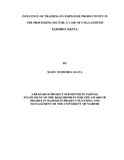| dc.description.abstract | The quality of Human Resource is an asset to any organization and as a result
Training has become an issue that has to be faced by every organization. The amount,
and quality of training carried out varies enormously from organization to organization
due to factors such as the degree of external change, for instance, new markets or new
processes, the adaptability of existing workforce and importantly the extent to which the
organization supports the idea of internal career development. The employees need to
be trained and the development of an employee to be highly skilled is essential. Most
organizations meet their needs for training in an ad hoc and haphazard way while others
set about identifying their training needs, then design training activities in a rational
manner and finally assess the results of training. The research study showed how
employee performance can be enhanced by proper training and development. For the
purpose of this study, Unga Limited was selected. This study, therefore, sought to
determine the influence of Training on employee productivity in the processing sector
using Unga Limited as the case of study. The research was intended to determine the
influence of training on employees with emphasis on the lower, middle level staff and
administrators of Unga Limited, who were randomly selected. The study also sought to
assess the training process of Unga Limited and whether training had improved
employee performance. A questionnaire was designed using structured questions to
collect primary data from employees of Unga Limited, and a total of 81 questionnaires
were distributed among the staff of the organization. Sixty five (65) completed
questionnaires were collected from the respondents; this figure being represented by
80%.This figure formed the foundation of the research. The results sought to indicate
the views of the employees of Unga Limited employees on the influence of knowledge
on their productivity. It also sought to determine the influence of attitude on employees‘
productivity. The study further sought to reveal whether skills gained from training had
any influence on employees‘ productivity. The study also sought to find out the
influence of capacity building on employee productivity. In general, the study also
sought to understand how skills, knowledge, attitude and capacity influenced employee
productivity in Unga Limited. The data collected was analyzed, tabulated, and presented
to show the relationship between independent and dependent variable. Correlation
analysis was done using Pearson‘s rank moment to determine the variables relationship.
Conclusions from the analysis were made, and recommendations made basing on the
findings. The study recommends that organizations should conduct training needs
assessment to ensure that the right training is given; ensure that their training
programmes should be on continuous basis; and motivate staff who performed
exceptionally during training sessions so that other staff will in turn aspire to excel | en_US |

